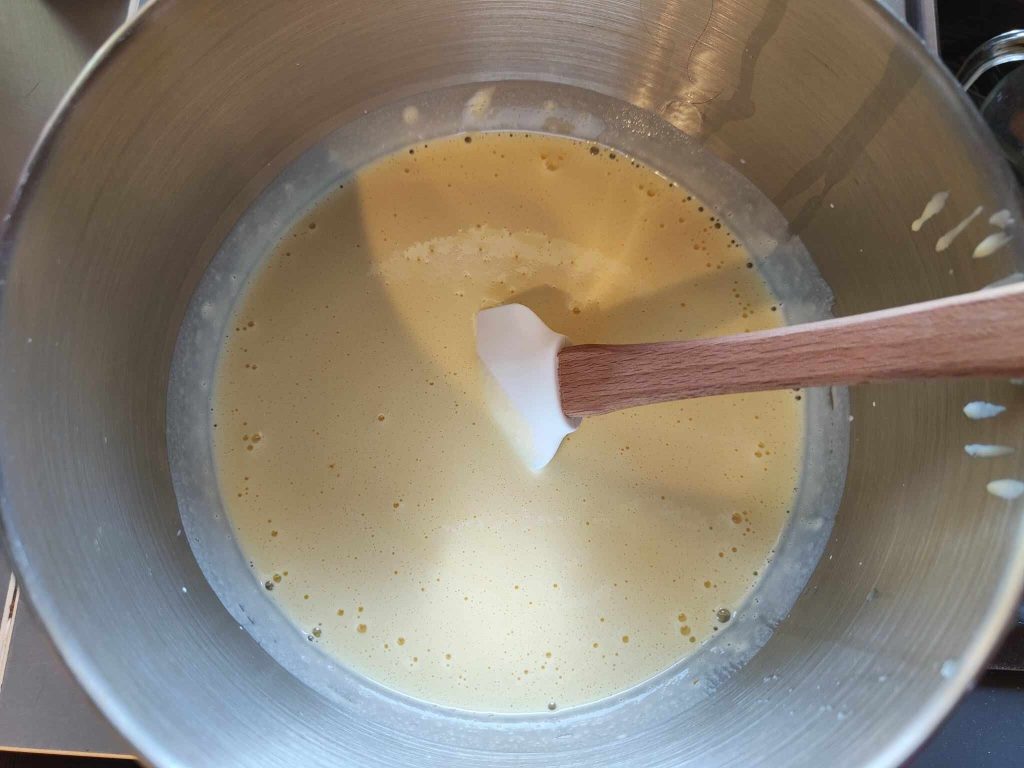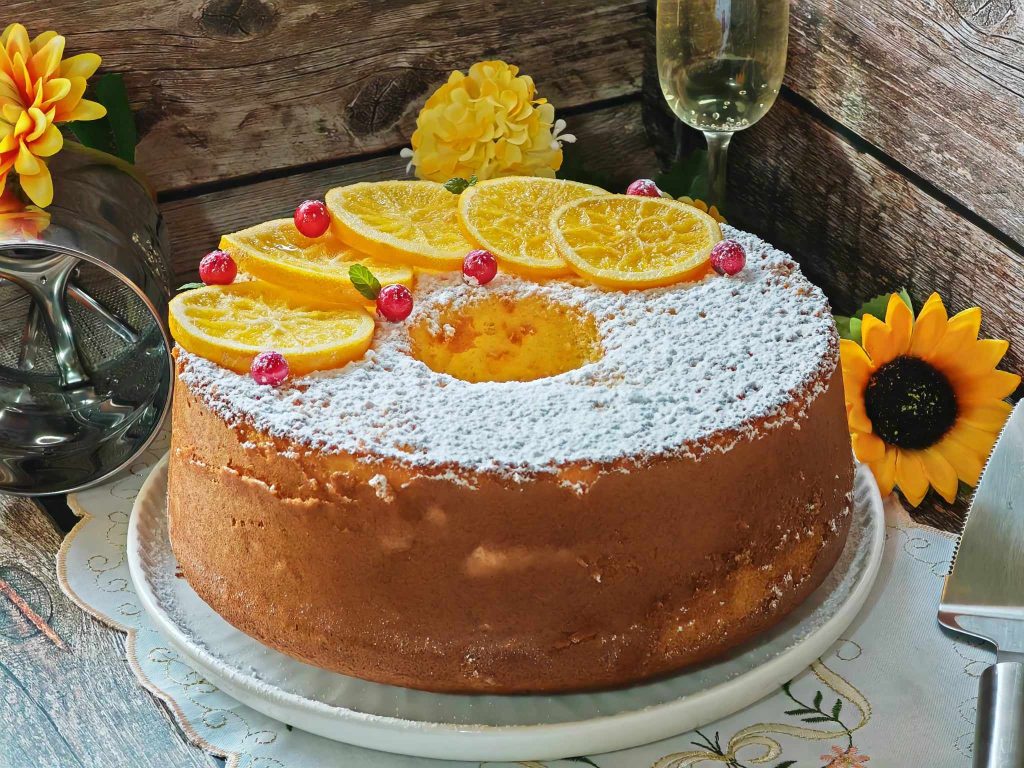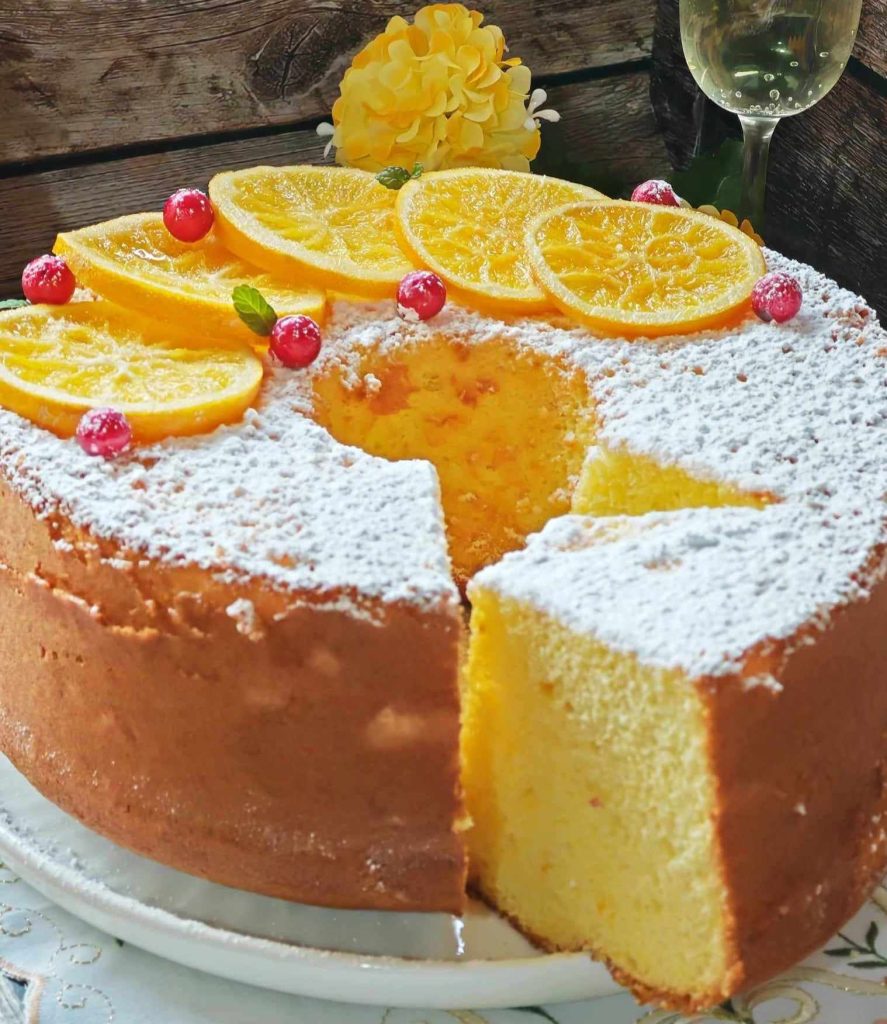Chiffon Cake is a tall, fluffy, and irresistibly delicious American cake. In this citrus version, the intense aroma of orange will not only intoxicate your kitchen but will surprise you from the first bite. Its texture is so extraordinarily soft that it literally feels like biting into a ‘cloud.’
Usually, it is baked in the specific chiffon cake mold.
My orange chiffon cake perfumed the entire kitchen, and it will be hard to wait for it to cool before tasting it… A generous sprinkle of powdered sugar will make it even more delicious.
We can enjoy it as it is, or we can cover it with chocolate glaze or orange or lemon glaze, or even slice it and layer it as we like!
The mold I used is 10 inches, but I repeat, reduce the doses if you have a smaller mold. You can easily find it in many homeware stores, or you can find it online at great prices.
Do not butter the inside of this mold; the batter should be poured without needing to butter and flour first.
The use of cream of tartar is very important in this cake, a natural leavening agent that in this recipe functions to stabilize the egg whites, and you can find it in supermarkets in the baking powder section.
If you don’t have it, you can easily prepare it by halving the ingredients and then baking it in a 10-inch bundt pan.
I used the juice of 3 oranges and their grated zest, it’s important to use organic and untreated oranges.
The obtained juice must be filtered.
For best results, both milk and eggs should be at room temperature, and flour and baking powder should be sifted.

- Difficulty: Easy
- Cost: Affordable
- Preparation time: 25 Minutes
- Portions: 14
- Cooking methods: Electric oven
- Cuisine: Italian
- Seasonality: All seasons
Ingredients for the Orange Chiffon Cake
- 7 eggs (room temperature)
- 2 1/2 cups all-purpose flour
- 1 1/3 cups sugar
- 1 orange (grated organic zest)
- 1/2 cup orange juice (from untreated oranges)
- 1/3 cup milk (room temperature)
- 1 packet baking powder
- 1/2 cup vegetable oil
- 1 tsp cream of tartar
- 1 pinch salt
Tools
- Mold
- Stand Mixer
- Electric Beaters
- Mixing Bowl
- Spatula
- Kitchen Scale
- Citrus Juicer
- Sieve
- Measuring Jug
- Grater
Steps for the Orange Chiffon Cake
Preheat the oven in static mode to 320°F. The Chiffon Cake mold (10-inch diameter) should not be greased or floured.
First, separate the yolks from the whites and place them in two different containers.
(The eggs should be at room temperature).
Wash and dry the oranges well.
Grate the zest of one orange (avoiding the bitter white part). Squeeze the oranges until you get 1/2 cup of juice, then filter it and leave it at room temperature.
In a large bowl, sift together the flour, baking powder, cream of tartar, and pinch of salt.

Start whipping the yolks with the sugar. You need to obtain a very light, fluffy, and frothy mixture.
Add the filtered orange juice to the whipped yolks, mixing well.
Add the milk and the vegetable oil. Mix until you get a smooth and homogeneous mixture.Gradually incorporate the dry ingredient mix (flour, baking powder, cream of tartar, and salt) into the yolk mixture. Mix only until the dry ingredients are fully combined. Finally, add the grated orange zest.

In a separate bowl, whip the egg whites to stiff peaks. Make sure the beaters are perfectly clean and dry, otherwise the egg whites will not whip properly.
Add the whipped egg whites to the base mixture in three additions.
Use a silicone spatula and mix slowly, with gentle upward movements, to not deflate the mixture and keep the incorporated air.

Pour the batter into the chiffon cake mold (not greased!).
Bake in a preheated oven at 320°F in static mode for about 55 to 60 minutes.
Do the toothpick test before taking it out of the oven.
Once cooked, immediately invert the mold and let the cake cool completely upside down (using the mold feet or a special rack).
The cake will detach from the mold walls by itself as it cools. If necessary, gently help with a thin knife only when it is completely cold.

Serve your fluffy Orange Chiffon Cake dusted with powdered sugar and maybe a few slices of fresh orange. The aroma and fluffiness are unbeatable!

Enjoy your meal.
Tips and Notes
It keeps well in a cake container for 5-6 days.
The basic ingredients are essential, and the process may seem simple, but as soon as you try variations and additions, you risk huge failures.
Why? The Chiffon Cake is a very tall cake, rich in eggs, low in animal fats, and has a delicate balance whose baking is slow and gradual.
Changing the quantities and ingredients may result in an incredibly moist cake almost raw or extremely dry and crumbly.
Unlike many other cakes, the Chiffon Cake prefers static oven mode.
The baking is also very particular: at 320°F for 55/60 minutes.
Never open the oven before 2/3 of the baking time, otherwise, it will deflate and remain raw inside.
If you liked this recipe, click on lots of stars, thank you very much.
Join my group: https://www.facebook.com/groups/488624465780860
or on my page: https://www.facebook.com/gustoamoreefantasie
Curiosities
The chiffon cake is a typically American cake, known for its softness and lightness. Its name (of French origin) is indeed reminiscent of a particularly delicate silk fabric.
This characteristic depends on the care with which the eggs are whipped but also on the addition of cream of tartar, a natural leavening agent that activates upon contact with liquids and, by reaction, develops carbon dioxide that allows for particularly fluffy and soft mixtures.
The chiffon cake mold also contributes, as it allows air passage and the homogeneous cooling of the cake, which thus results in being as light as a cloud.
FAQ (Frequently Asked Questions)
Why didn’t you grease the mold?
Not greasing or oiling the mold is fundamental for this reason: this cake has such a delicate balance that it needs to adhere to the sides and center of the support tin as it rises or it will collapse or deflate.
This is why you will always find remnants of the batter along the central funnel and the mold’s edges.Why didn’t it rise well?
This issue may be caused by improper handling of the egg whites.
The egg whites may have been over or under-whipped, leading to suboptimal height.
Or it could stem from the way the whites were incorporated into the rest of the mixture: stirring too much and improperly can cause excess air formation.
Remember not to use cold egg whites from the fridge: they should be at room temperature.
Finally, it may have been caused by too low an oven temperature.

